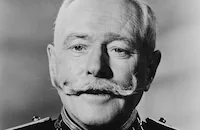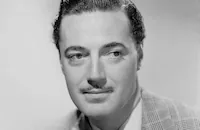Tarzan's Peril

Brief Synopsis
Cast & Crew
Byron Haskin
Lex Barker
Virginia Huston
George Macready
Douglas Fowley
Glenn Anders
Film Details
Technical Specs

Synopsis
In the jungles of British East Africa, the coronation of Melmendi, the queen of the Ashuba tribe, is observed by commissioner Peters, who is about to retire, and his replacement, Connors. As the ceremony concludes, Peters tells Connors about Bulam, the brutal chieftain of the neighboring Yorango tribe, whose marriage proposal Melmendi has just rejected. Noting that he has always kept gin and guns away from the natives, Peters then warns Connors about outsiders selling arms to the villagers and fomenting unrest. Unknown to Peters, Radijeck, a ruthless "slaver," has just escaped from prison and, with his cohorts, Andrews and Herbert Trask, is bringing in a load of illegal rifles to the area. Meanwhile, in a nearby section of jungle, wild man Tarzan learns about Radijeck's escape and, accompanied by his chimpanzee companion Cheetah, races to inform Peters. Later, at his treehouse, a worried Tarzan tells his wife Jane the news about Radijeck, whom Jane unwittingly nursed back to health years before. Tarzan and Jane then discover that the mischievous Cheetah appropriated Peters' confidential notebook, and all three set out the next day for Peters' office in Randini. At the same time, Peters and Connors intercept one of Radijeck's porters in the jungle and become suspicious. To avoid detection, Radijeck orders Trask to impersonate a missionary and claim the porters are carrying Bibles. The ploy fails, however, and to Andrews' and Trask's horror, Radijeck guns down the commissioners. After Radijeck forces Andrews to take Peters' pocket watch, he and a now-wary Andrews and Trask resume their trek. Later, while climbing a steep cliff, Radijeck deliberately drops a boulder on Andrews, breaking his leg. Radijeck and Trask leave Andrews to die, but Andrews crawls into the nearby river and, while grasping some fallen branches, is carried along by the current. Tarzan, Jane and Cheetah, who are traveling by canoe, spot Andrews just as some crocodiles are about to attack him, and Tarzan swims to Andrews' rescue. Tarzan pulls the unconscious Andrews to shore, where Cheetah discovers Peters' watch, an object with which the chimp has long been fascinated. Recognizing the watch, Tarzan and Jane go to see the governor in Randini, after delivering Andrews to the doctor. Although the governor expresses little concern about Peters and Connors' absence, Tarzan is uneasy and decides to investigate. Radijeck and Trask, meanwhile, arrive at the Yorango village and negotiate a deal with Bulam, exchanging guns for gems. Nearby, surrounded by hyenas and buzzards, Tarzan finds Peters' bullet-riddled helmet and deduces his fate. From a tree top, Tarzan then spots Bulam and Radijeck passing by and, swinging from vine to vine, beats them to the safari camp where Trask and some Yorango men are guarding the rifles. Tarzan overwhelms Trask and the guards, but is soon trapped and knocked out by Radijeck. Radijeck and Trask throw the unconscious Tarzan in the river and, after seeing him go over a waterfall while clinging to some branches, conclude he is dead. After receiving their payment, Radijeck and Trask part ways with Bulam, taking a few natives with them as guides. Bulam's armed warriors then attack Melmendi's village, easily overpowering them. Meanwhile, having been washed ashore, Tarzan revives, but must immediately free himself and a baby elephant from a giant, voracious plant. With Cheetah, Tarzan rushes toward Melmendi's village and attacks a spear-wielding Yorango warrior who is chasing an Ashuba boy named Nessi. After instructing Nessi to sneak back to his village and free the bound Ashuba tribesmen while Bulam's men are sleeping, Tarzan rescues the heavily guarded Melmendi. Soon, most of the Ashubas are freed and, seizing the rifles, battle Bulam's warriors. Once the Yorangos are driven from the village, Tarzan vows to capture Radijeck. Radijeck and Trask, meanwhile, wake up to discover their guides have deserted them, and when Trask panics, Radijeck kills him. An exhausted Radijeck eventually finds Jane in the treehouse and tries to force her to help him. When Tarzan suddenly appears, Radijeck grabs Jane and holds her at gunpoint. Radijeck then empties his gun shooting at Tarzan, who is swinging from tree to tree. Unharmed, Tarzan swoops down and knocks Radijeck off the treehouse, killing him. Tarzan and a relieved Jane then embrace, while Cheetah swallows Peters' watch and belches.

Director

Byron Haskin
Cast

Lex Barker

Virginia Huston

George Macready

Douglas Fowley
Glenn Anders

Dorothy Dandridge

Alan Napier
Frederick O'neal

Edward Ashley
Cheetah, A Chimp
James Moultrie

Walter Kingsford
Wesley Gale
Bill Washington
Martin Wilkins
Frances Driver
Robert Davis
Milton Wood

Joel Fluellen
Jack Williams
Maxie Thrower
James Frazier
Florence Robertson
Stanley Logan
Bruce Lester
Evelyn Burwell
Chester Jones
Lawrence Lamar
Crew
Fred Ahern
Cliff Brandon
Phil Brandon
Don Cash
Peter Colemore
Buster Cooke
John Cousins
Tony Dean
Wesley Jeffries
Fred Lau
Sol Lesser
John Meehan
Michel Michelet
Claud Morris
Jack Murray
Samuel Newman
James Paisley
Karl Struss
Francis Swann
Jack Whitehead

Film Details
Technical Specs

Articles
Tarzan's Peril
The film opens on an African drum ceremony under the credits; very noticeable is the fact that the close-ups of hands beating a variety of functional drums is the real stuff and not Hollywood fakery. Wide shots following the credits feature more genuine footage of tribal dancing. The authenticity properly established, other footage shot on Hollywood soundstages is intercut, although it is clear that the African footage is not "stock" - it shows leading characters establishing story points specific to this movie (although they are shown in long shot, indicating that doubles for the actors were filmed on location).
The dance ceremony is in honor of Melmendi (Dorothy Dandridge), Queen of the Ashuba tribe. The ceremony is observed by the local British East Africa commissioner Peters (Alan Napier) along with his just-arrived replacement, Connors (Edward Ashley). The elderly Peters is retiring after thirty years of service - experienced movie watchers know that this is a death sentence for any well-liked civil servant and that his subsequent line of dialogue, "So far I've been able to keep guns and gin out of the territory," is a major hint of the evil that will soon invade his peaceful terrain. As if on cue, the audience is introduced to Radijeck (George Macready in a wonderfully villainous performance), who has just escaped from prison, and who along with his two cronies Trask (Douglas Fowley) and Andrews (Glenn Anders), plans to sell guns to Bulam (Frederick O'Neal), the brutal King of the neighboring Yorango tribe. Jane (Virginia Huston) hears of Radijeck's escape and is concerned for Tarzan (Lex Barker), who brought Radijeck to justice previously. Radijeck does have revenge on his mind and proceeds to commit multiple murders, terrorize Jane, and kidnap Queen Melmendi.
Sol Lesser and company, including second unit director Phil Brandon, departed for Africa in July of 1950, and filmed with Technicolor cameras in Kenya (British East Africa) - primarily in Meru National Park, and also in Uganda and Tanganyika. The timing of their trip was a miscalculation, because warm months above the equator are cold below - the primary trouble they encountered was an almost ever-present layer of fog. According to author Gabe Essoe (in Tarzan of the Movies: A Pictorial History of More Than Fifty Years of Edgar Rice Burroughs' Legendary Hero, Citadel Press, 1972), "...the location site at the base of Mount Kenya was always so cloudy that Tarzan lost his tan, and an urgent call was sent to Hollywood for more body make-up." Lex Barker told Essoe, "We just weren't prepared for location conditions. Local natives were rounded up, and the first time I appeared in the jungle in my loincloth, they burst out laughing. It was demoralizing." Barker also described an incident in which "...the director wanted me to tangle with a man-eating plant. I told him that I would only wrestle a plant that had sense enough to let go on cue. I eventually battled one back in Hollywood that the RKO special effects department built."
The most serious problem on the African shoot, however, was an accident which resulted in half of the color footage being ruined. The company returned to Hollywood in late August and Lesser decided to shoot Tarzan's Peril in black-and-white and incorporate what African footage he could salvage in matching monochrome. (Some of this material would later be used as stock footage - and seen as intended - starting in 1957 when the Tarzan series switched to color). Sadly, any footage of Barker as Tarzan must have been amongst the ruined reels, because all of his scenes in the finished film are sourced from Hollywood soundstages. As it stands, the best sequence shot in Africa is a rousing assault on the peaceful Ashuba village by the gun-toting warriors of the Yorango tribe. Despite the problems, the effort to capture genuine scenes in Africa give the film a sense of scope and verisimilitude that previous Tarzan pictures could not approach. It helped, also, that the integration of the footage was very skillfully handled by director Byron Haskin.
Tarzan's Peril opened in March, 1951. The critic for Variety noted that the film "...has the familiar ingredients of jungle adventure, plus good background footage actually lensed in Africa." This writer noted that "Virginia Huston has only a few scenes as Tarzan's mate, Jane, in the footage. There's more emphasis on Dorothy Dandridge, queen of a tribe that is saved by Tarzan from its warring rivals." Certainly, the film was an enormous boost in notoriety and publicity for Dandridge, who was just two years away from her breakout role in Bright Road (1953). Donald Bogle (in his book Toms, Coons, Mulattoes, Mammies, and Bucks: An Interpretive History of Blacks in American Films, Continuum 2001) described the film as "...typical jungle fare with one twist. In a crucial episode, Dandridge, as a kidnapped African princess, was tied to the stakes by a warlike tribal leader. As she lay with legs sprawled apart, heaving and turning to break loose, it was apparent that never before had the black woman been so erotically and obviously used as a sex object. From the way Lex Barker's Tarzan eyed the sumptuous Dandridge, it was obvious too, that for once Tarzan's mind was not on Jane or Boy or Cheetah!"
Producer: Sol Lesser
Director: Byron Haskin
Screenplay: Samuel Newman, Francis Swann (original screenplay); John Cousins (additional dialogue); Edgar Rice Burroughs (characters)
Cinematography: Karl Struss
Art Direction: John Meehan
Music: Michel Michelet
Film Editing: John Murray
Cast: Lex Barker (Tarzan), Virginia Huston (Jane), George Macready (Radijeck), Douglas Fowley (Herbert Trask), Glenn Anders (Andrews), Alan Napier (Commissioner Peters), Edward Ashley (Conners), Dorothy Dandridge (Melmendi, Queen of the Ashuba), Walter Kingsford (Barney), Frederick O'Neal (King Bulam)
BW-79m.
By John M. Miller

Tarzan's Peril
Quotes
Trivia
Notes
The working title of this film was Tarzan's Mate in Peril. During production, the title was changed from Tarzan's Peril to Tarzan's Mate in Peril back to Tarzan's Peril. The film's onscreen title card reads: "Edgar Rice Burroughs' Tarzan's Peril." Tarzan's Peril was the first "Tarzan" picture to be filmed in large part in Africa. According to various Hollywood Reporter news items, exterior filming took place from July to September 1950 in Kenya (British East Africa), including Meru National Park, as well as Uganda and Tanganyika.
After eight weeks of interior shooting at the RKO-Pathé Studios in Culver City, CA, the production continued filming in Chapultepec Park in Mexico City, according to a news item. Although an October 1950 Hollywood Reporter news item announced that singer Josh White had been signed for a role, his appearance in the final film has not been confirmed. For more information about the "Tarzan" series, consult the Series Index and see the entry for Tarzan, the Ape Man in AFI Catalog of Feature Films, 1931-40, and the entry for Tarzan Triumphs in AFI Catalog of Feature Films, 1941-50.














